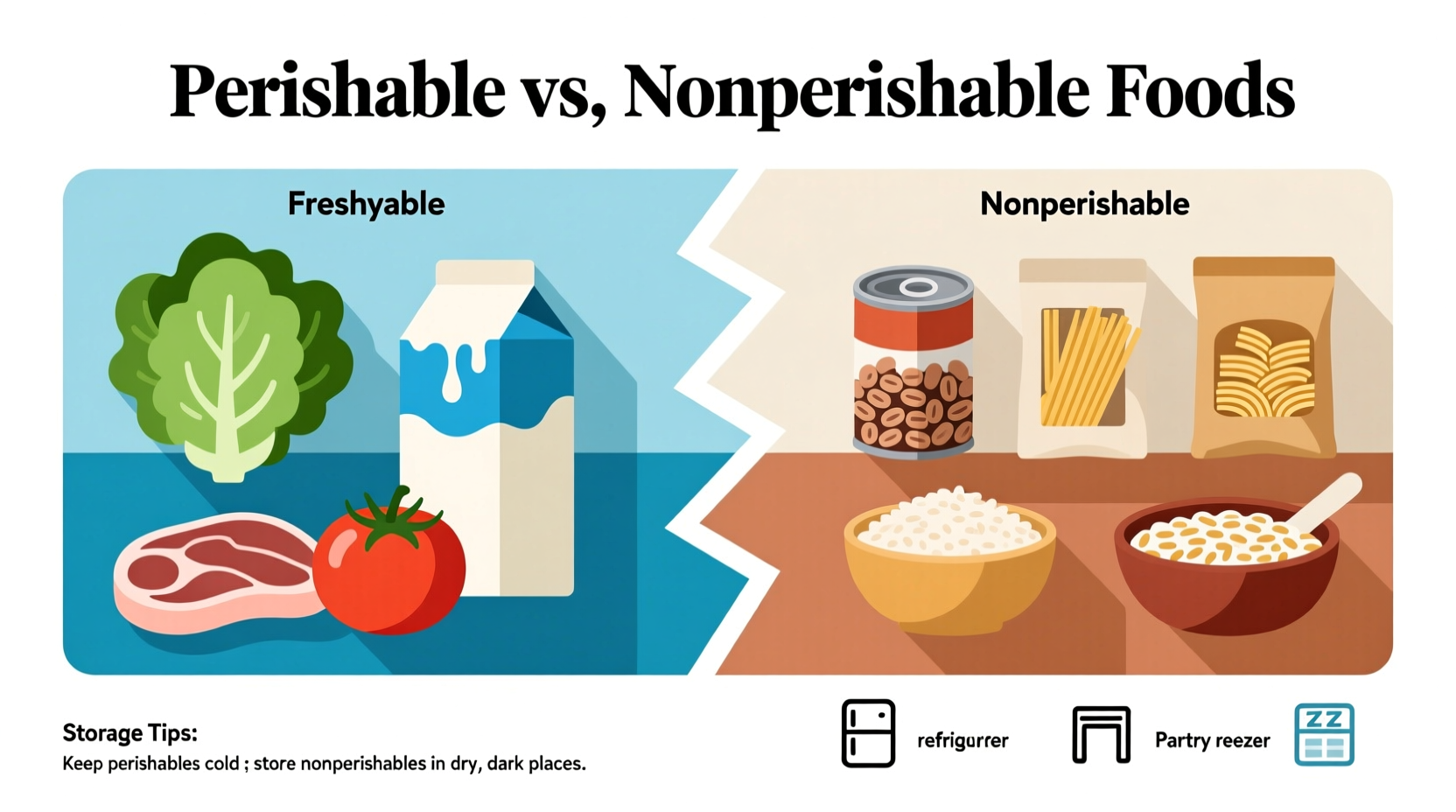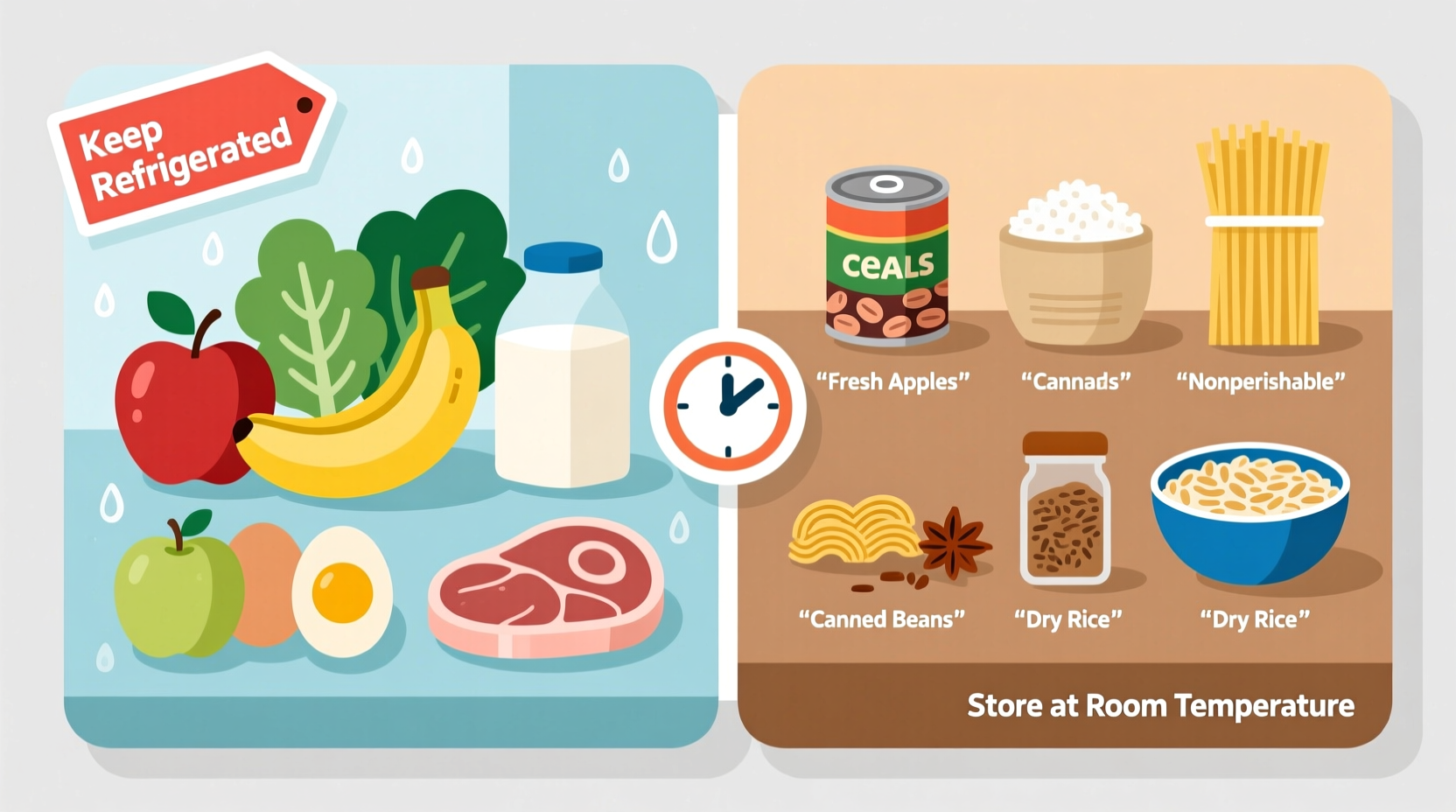Ever wonder why some foods spoil quickly while others seem to last forever? Knowing the difference between perishable and nonperishable foods isn't just kitchen trivia—it's essential for food safety, budget management, and reducing waste. In this comprehensive guide, you'll discover exactly how to identify each category, learn proper storage techniques, and understand the science behind food spoilage. By the end, you'll have practical knowledge to keep your kitchen safe and your groceries lasting longer.
Defining Perishable Foods: The Time-Sensitive Category
Perishable foods contain high moisture content and nutrients that create ideal conditions for bacterial growth. These items typically require refrigeration below 40°F (4°C) and have a limited shelf life. The USDA Food Safety and Inspection Service identifies perishable foods as those that will spoil, decay, or become unsafe to eat within a short period if not properly stored.
Common examples include:
- Fresh meats, poultry, and seafood
- Dairy products (milk, cheese, yogurt)
- Eggs
- Most fruits and vegetables
- Cooked leftovers
- Opened canned goods
These foods generally remain safe for consumption for 1-7 days under proper refrigeration. The exact timeframe depends on specific storage conditions and the food's initial quality. For instance, raw chicken lasts 1-2 days in the refrigerator, while properly stored carrots can remain fresh for 2-3 weeks.
Understanding Nonperishable Foods: Long-Term Storage Options
Nonperishable foods maintain safety and quality for extended periods without refrigeration due to low moisture content, high acidity, or preservation methods. The FDA Food Code defines these items as having a shelf life of at least 30 days under normal storage conditions, though many last significantly longer.
Typical nonperishable foods include:
- Dried beans and legumes
- White rice and pasta
- Canned goods (properly sealed)
- Honey and pure maple syrup
- Peanut butter (unopened)
- Dried herbs and spices
- Dark chocolate (70%+ cocoa)
While these items don't require refrigeration, proper storage in cool, dry places extends their quality. For example, unopened canned goods typically remain safe for 2-5 years, while dried beans can last indefinitely when stored correctly—though their quality gradually declines after 1-2 years.
| Characteristic | Perishable Foods | Nonperishable Foods |
|---|---|---|
| Moisture Content | High (typically >60%) | Low (typically <15%) |
| Refrigeration Required | Yes (below 40°F/4°C) | No |
| Typical Shelf Life | 1-7 days refrigerated | Months to years |
| Common Preservation Methods | Refrigeration, freezing | Canning, drying, salting, sugaring |
| Signs of Spoilage | Odor changes, mold, texture changes | Rancidity, color changes, insect infestation |
Food Safety Implications of Misclassification
Mistaking perishable foods for nonperishable items creates serious health risks. The Centers for Disease Control and Prevention reports that improper food storage causes approximately 48 million cases of foodborne illness annually in the United States. Temperature abuse—leaving perishable foods in the "danger zone" between 40°F and 140°F—is a leading cause.
Consider these critical distinctions:
- Fresh herbs are perishable (1-2 weeks refrigerated), while dried herbs are nonperishable (1-3 years)
- Opened tomato sauce becomes perishable (5-7 days), while unopened cans remain nonperishable
- Hard cheeses like parmesan have longer shelf life than soft cheeses like brie
Understanding these nuances prevents foodborne illness. For example, many people mistakenly believe that bread is nonperishable, but it actually falls into a semi-perishable category—mold can develop within days at room temperature, though freezing extends its life significantly.

Practical Storage Guidelines for Maximum Safety
Proper storage techniques maximize the shelf life of both categories. The USDA recommends these evidence-based practices:
For Perishable Foods:
- Store meat on the bottom refrigerator shelf to prevent cross-contamination
- Keep dairy products in the main compartment (not the door where temperatures fluctuate)
- Use airtight containers for leftovers and label with dates
- Follow the "two-hour rule": refrigerate perishables within two hours of cooking (one hour if room temperature exceeds 90°F)
For Nonperishable Foods:
- Store in cool, dry places away from heat sources
- Transfer opened packages to airtight containers
- Rotate stock using the "first in, first out" method
- Check cans for dents, leaks, or bulging before use
Remember that some foods transition categories based on processing. Fresh tomatoes are perishable, but canned tomatoes become nonperishable until opened. Similarly, dried fruits have extended shelf life compared to their fresh counterparts, though they eventually become susceptible to mold in humid conditions.
Common Misconceptions About Food Shelf Life
Several widespread myths lead to unnecessary food waste or safety risks. Research from the National Center for Home Food Preservation reveals that "best by" dates often confuse consumers—they indicate peak quality, not safety. Many nonperishable foods remain safe well beyond these dates when stored properly.
Key clarifications:
- Honey never spoils but may crystallize—this doesn't indicate spoilage
- Vinegar-based products like pickles remain safe for 1-2 years after opening when refrigerated
- "Sell by" dates apply to retailers, not consumers' safety timelines
- Freezing stops bacterial growth but doesn't kill existing bacteria
Understanding these distinctions helps reduce the estimated 30-40% of food waste in American households, much of which stems from misinterpreting food safety guidelines.
Seasonal and Environmental Factors Affecting Food Classification
Food categorization isn't always absolute—environmental conditions can transform nonperishable items into perishable ones. During summer months or in humid climates, even traditionally nonperishable foods like flour and cereal become vulnerable to insect infestation and mold growth. The USDA notes that storage conditions significantly impact actual shelf life.
Consider these context-dependent scenarios:
- In tropical climates, unrefrigerated eggs may last only 3-5 days versus 3-5 weeks in refrigerated conditions
- Dehydrated foods maintain quality longer in arid environments than humid ones
- Power outages transform refrigerated perishables into time-sensitive safety concerns
Adapting storage practices to your specific environment ensures food safety regardless of general classifications. This contextual understanding separates basic knowledge from truly practical food management skills.











 浙公网安备
33010002000092号
浙公网安备
33010002000092号 浙B2-20120091-4
浙B2-20120091-4